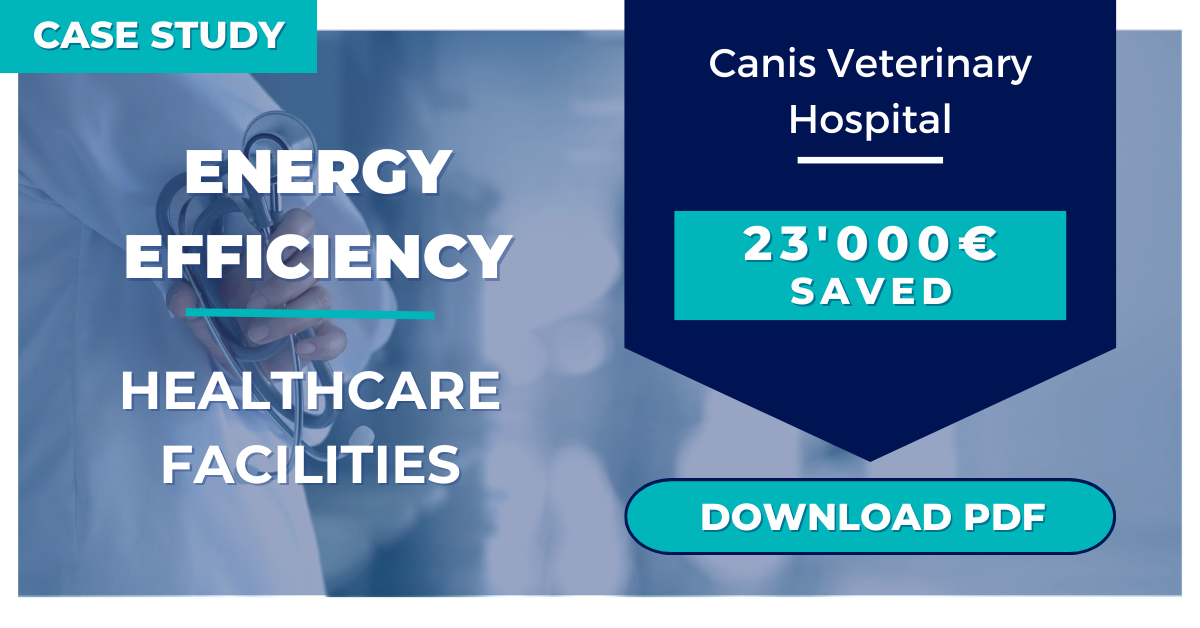Hospitals and clinics are among the healthcare facilities that need a proper Energy Management plan. Such buildings need to be energy efficient as they ensure uninterrupted operational services all year round!
In this case study, specially dedicated to health care facilities, discover how the Canis Veterinary Hospital managed to deploy an energy efficiency plan and save more than €23,000, with the help of Dexma’s partner company Audit Energia.
Energy Efficiency in Health Care Facilities
The current energy context means that energy prices are rising and increasing the risk of power cuts. As mentioned several times it is important to reinforce our efforts in energy sobriety and efficiency to limit the impact on the market and avoid blackouts. This applies to all sectors, particularly the health sector where outages could be catastrophic for the proper functioning of equipment and operational services.
Energy efficiency in hospitals and clinics is of vital importance no matter the species of the patients. Why? Because healthcare facilities typically require a large amount of uninterrupted energy supply.
In the UK, healthcare facilities may also have to meet energy-related regulatory requirements. Some examples of these regulatory requirements include but are not limited to:
- Display Energy Certificates (DECs): Healthcare facilities with a floor area over 250 square meters must display a valid DEC, which rates the energy efficiency of the building on a scale from A to G. This requirement is part of the Energy Performance of Buildings Regulations.
- Energy Performance Certificates (EPCs): Healthcare facilities must have a valid EPC, which rates the energy efficiency of the building on a scale from A to G. This requirement is also part of the Energy Performance of Buildings Regulations.
- Minimum Energy Efficiency Standards (MEES): Healthcare facilities must comply with MEES, which require that commercial buildings have an EPC rating of at least E, unless an exemption applies. This requirement is also part of the Energy Performance of Buildings Regulations.
- Climate Change Agreements (CCAs): Healthcare facilities may be eligible to participate in CCAs, which provide a discount on the Climate Change Levy for facilities that meet energy efficiency targets.
- Carbon Reduction Commitment (CRC) Energy Efficiency Scheme: Healthcare facilities that consume more than 6,000 MWh of electricity per year must participate in the CRC, which requires facilities to purchase carbon allowances to cover their carbon emissions.
As we just saw, hospitals and clinics are not exempt when it comes to making efforts to save energy, whether to comply with regulations or to obtain certification (such as ISO 50001, for example). These efforts are particularly requested by governments, notably in the framework of the European Energy Sobriety Plan.
Let’s now discuss how to implement an energy efficiency plan in veterinary hospitals.
Energy Efficiency in Veterinary Hospitals
Energy efficiency in hospitals and clinics is of vital importance, regardless of the type of patient. Healthcare facilities generally require a large amount of energy on a continuous basis.
Veterinary clinics generally have similar energy requirements to any medical facility, as they provide the same type of health care as in other so-called conventional facilities. Some examples are
- Keeping patients (our pets) and healthcare personnel as comfortable as possible
- Regulatory compliance with strict health and safety protocols
- Proactive maintenance of facilities and equipment.
- Securing an uninterrupted energy supply
For facilities that provide healthcare services, such as hospitals or veterinary clinics, energy spending accounts for about 20% of fixed costs. Reducing energy consumption therefore not only results in helping the hospital drive down those fixed costs but also helps the entire facility become more efficient and environmentally sustainable.
Let’s have a look at the success story of the Canis Veterinary Hospital which worked with Audit Energia on a solid Energy Management plan in order to reduce its energy consumption and therefore its costs on the final energy bill. Audit Energia, Dexma’s partner and energy management expert, has extensive experience in implementing energy efficiency projects in the health sector. It has a track record of success in energy management, particularly in clinics and hospitals.
Energy saving plan for the Canis Veterinary hospital
The Canis Veterinary Hospital in Girona, Spain, provides animal care 24 hours a day, 365 days a year. Its facility measures more than 2,000 m2 and includes:
- 6 consultation rooms
- 3 operating rooms
- Pre-surgery room
- Laboratory
- Radiology room
- Ultrasound room
- Rehabilitation room
Add to all of that the individual rooms for pet hospitalisation, including “suites” for larger animals, plus their corresponding outdoor patios. Being both very large and multifunctional, this healthcare facility requires an uninterrupted energy supply.
Canis Veterinary Hospital also has an excellent Indoor Air Quality (IAQ) rating thanks to a sophisticated ventilation and air purification system that prevents potential infections from air pollution or foul odours.
As a result, the management team at Canis Veterinary Hospital quickly realized the importance of a sound energy management plan for their various healthcare facilities. Their energy challenges were as follows:
- Optimise energy procurement (energy and contracted power). In a hospital, contracted power becomes vital since full services must be provided to emergency facilities that cannot lose their power supply under any circumstances.
- Detect the appropriate level of daily energy consumption (i.e. which loads are consuming the highest amount of energy) as well as nightly consumption (to understand what can be reduced). In the case of Canis, the challenge was to start monitoring the main meter, which had never been accounted for in the overall assessment of the building’s energy use.
- Install renewable energy sources (Canis opted for a rooftop solar installation) to advance self-generation capabilities.
- Following the rooftop solar installation, the final challenge was to monitor and optimise the hospital’s sub-metering situation.
As part of its intervention, Audit used the Dexma Energy Management Platform to carry out an exhaustive analysis of consumption and under-consumption, detecting problem areas and implementing energy-saving measures that resulted in a 59% saving in energy consumption and a 68% reduction in the final energy bill of the Canis Veterinary Hospital. As a result, the hospital made a total saving of more than 23,000 euros!
Dexma not only helped Audit Energía to analyse the existing under-consumption but also played a fundamental role in the management of the solar photovoltaic installation on the roofs of the Canis Veterinary Hospital. Thanks to “SolarView”, an application specially designed for solar energy management, the hospital is able to monitor and manage its solar electricity production in an optimal way.
If you would like to find out more about how Audit Energia and Canis Veterinary Hospital achieved this energy success story together, download the full case study here or below:




